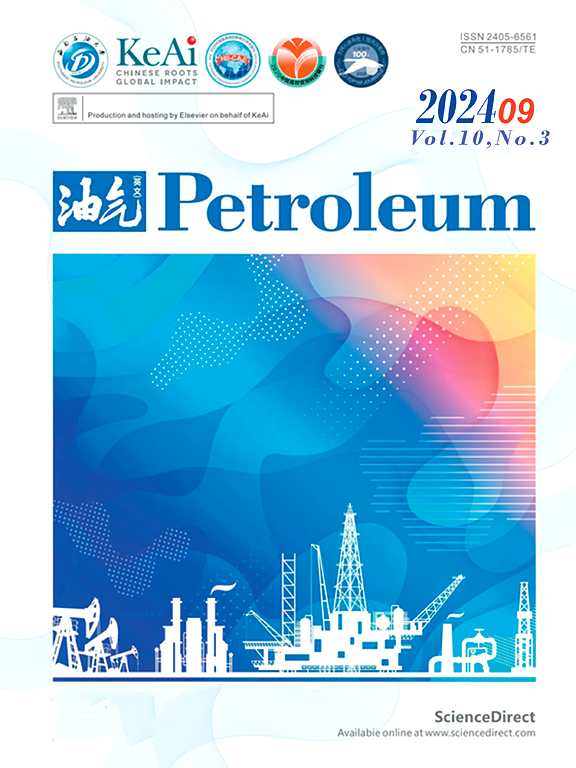Nanoparticle-stabilized CO2 foam flooding for enhanced heavy oil recovery: A micro-optical analysis
IF 4.2
Q2 ENERGY & FUELS
引用次数: 0
Abstract
Surfactant flooding is a well-known chemical approach for enhancing oil recovery. Surfactant flooding has the disadvantage that it cannot withstand the harsh reservoir conditions. Improvements in oil recovery and release are made possible by the use of nanoparticles and surfactants and CO2 co-injection because they generate stable foam, reduce the interfacial tension (IFT) between water and oil, cause emulsions to spontaneously form, change the wettability of porous media, and change the characteristics of flow. In the current work, the simultaneous injection of SiO2, Al2O3 nanoparticles, anionic surfactant SDS, and CO2 in various scenarios were evaluated to determine the microscopic and macroscopic efficacy of heavy oil recovery. IFT (interfacial tension) was reduced by 44% when the nanoparticles and SDS (2000 ppm) were added, compared to a reduction of roughly 57% with SDS only. SDS-stabilized CO2 foam flooding, however, is unstable due to the adsorption of SDS in the rock surfaces as well as in heavy oil. To assess foam's potential to shift CO2 from the high permeability zone (the thief zone) into the low permeability zone, directly visualizing micromodel flooding was successfully executed (upswept oil-rich zone). Based on typical reservoir permeability fluctuations, the permeability contrast (defined as the ratio of high permeability to low permeability) for the micromodel flooding was selected. However, the results of the experiment demonstrated that by utilizing SDS and nanoparticles, minimal IFT was reached. The addition of nanoparticles to surfactant solutions, however, greatly boosted oil recovery, according to the findings of flooding studies. The ultimate oil recovery was generally improved more by the anionic surfactant (SDS) solution including nanoparticles than by the anionic surfactant (SDS) alone.
纳米颗粒稳定的二氧化碳泡沫用于重油强化采收:微光学分析
表面活性剂驱油是一种众所周知的提高石油采收率的化学方法。表面活性剂驱的缺点是不能承受恶劣的储层条件。通过使用纳米颗粒、表面活性剂和二氧化碳共注入,可以产生稳定的泡沫,降低水和油之间的界面张力(IFT),使乳液自发形成,改变多孔介质的润湿性,并改变流动特性,从而提高采收率和释放量。本研究通过对不同场景下同时注入SiO2、Al2O3纳米颗粒、阴离子表面活性剂SDS和CO2进行评价,以确定稠油采收率的微观和宏观效果。当加入纳米颗粒和SDS (2000 ppm)时,界面张力降低了44%,而仅添加SDS时,界面张力降低了约57%。然而,由于SDS在岩石表面和稠油中的吸附,SDS稳定的CO2泡沫驱并不稳定。为了评估泡沫将二氧化碳从高渗透层(盗贼层)转移到低渗透层的潜力,成功地直接可视化了微模型驱油(上掠富油层)。基于典型储层渗透率波动,选择微模型驱的渗透率对比(定义为高渗透与低渗透之比)。然而,实验结果表明,使用SDS和纳米颗粒可以达到最小的IFT。然而,根据驱油研究的结果,在表面活性剂溶液中加入纳米颗粒可大大提高采收率。含有纳米颗粒的阴离子表面活性剂(SDS)溶液通常比单独使用阴离子表面活性剂(SDS)更能提高最终采收率。
本文章由计算机程序翻译,如有差异,请以英文原文为准。
求助全文
约1分钟内获得全文
求助全文
来源期刊

Petroleum
Earth and Planetary Sciences-Geology
CiteScore
9.20
自引率
0.00%
发文量
76
审稿时长
124 days
期刊介绍:
Examples of appropriate topical areas that will be considered include the following: 1.comprehensive research on oil and gas reservoir (reservoir geology): -geological basis of oil and gas reservoirs -reservoir geochemistry -reservoir formation mechanism -reservoir identification methods and techniques 2.kinetics of oil and gas basins and analyses of potential oil and gas resources: -fine description factors of hydrocarbon accumulation -mechanism analysis on recovery and dynamic accumulation process -relationship between accumulation factors and the accumulation process -analysis of oil and gas potential resource 3.theories and methods for complex reservoir geophysical prospecting: -geophysical basis of deep geologic structures and background of hydrocarbon occurrence -geophysical prediction of deep and complex reservoirs -physical test analyses and numerical simulations of reservoir rocks -anisotropic medium seismic imaging theory and new technology for multiwave seismic exploration -o theories and methods for reservoir fluid geophysical identification and prediction 4.theories, methods, technology, and design for complex reservoir development: -reservoir percolation theory and application technology -field development theories and methods -theory and technology for enhancing recovery efficiency 5.working liquid for oil and gas wells and reservoir protection technology: -working chemicals and mechanics for oil and gas wells -reservoir protection technology 6.new techniques and technologies for oil and gas drilling and production: -under-balanced drilling/gas drilling -special-track well drilling -cementing and completion of oil and gas wells -engineering safety applications for oil and gas wells -new technology of fracture acidizing
 求助内容:
求助内容: 应助结果提醒方式:
应助结果提醒方式:


